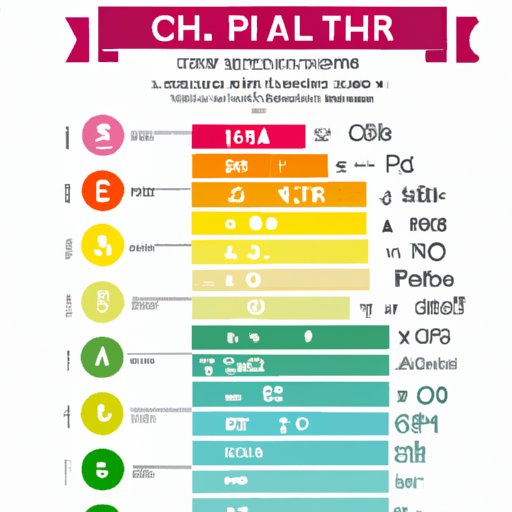Introduction
pH is an abbreviation for ‘potential of hydrogen’ which is a measure of acidity or alkalinity in a given solution. It is a numerical scale ranging from 0 to 14 with 7 being neutral, anything below 7 is acidic and anything above 7 is alkaline. Understanding the pH scale is important as it can have a major impact on many areas including chemical reactions, human health and industrial processes.
Explaining the Basics of How pH Scale Works
The pH scale is used to measure the concentration of hydrogen ions in a solution. The lower the pH, the higher the concentration of hydrogen ions which means the solution is more acidic. Conversely, the higher the pH of a solution, the lower the concentration of hydrogen ions and the solution is more alkaline. The pH scale is logarithmic, meaning each unit on the scale is 10 times higher or lower than the one before or after it. This means that a solution that has a pH of 5 is 10 times more acidic than a solution with a pH of 6 and 100 times more acidic than a solution with a pH of 7.
Exploring the Relationship Between pH and Acidity
The pH scale is used to measure the acidity or alkalinity of a solution. Acids are substances that release hydrogen ions when dissolved in water, while bases are substances that release hydroxide ions when dissolved in water. The more hydrogen ions present in a solution, the more acidic it is, and the more hydroxide ions present in a solution, the more alkaline it is. The pH scale is used to measure the amount of hydrogen ions in a solution and thus determine its acidity or alkalinity.

Breaking Down the Different Levels of pH
The pH scale is divided into 14 different levels with 7 being neutral. Anything below 7 is considered acidic and anything above 7 is considered alkaline. Examples of different pH levels in everyday life include stomach acid which has a pH of 1-3, blood which has a pH of 7.35-7.45 and household bleach which has a pH of 12-13. The pH level of a solution can have a significant impact on chemical reactions, as certain reactions may only occur at certain pH levels.

Examining the Effects of pH on Chemical Reactions
The pH of a solution can have a major effect on chemical reactions. For example, some enzymes only function at specific pH levels, and if the pH of the environment changes, the enzyme may no longer be able to catalyze the reaction. Additionally, many chemicals are only soluble in solutions with a certain pH range, so if the pH of the solution is not within the correct range, the chemical will not dissolve. It is therefore important to understand how pH affects chemical reactions in order to ensure successful outcomes.
Analyzing Different Applications of pH Measurement
The pH scale is used in a variety of industries such as food production, water treatment, agriculture and medicine. In food production, pH measurements are used to control the acidity of foods and beverages, while in water treatment they are used to test water quality and monitor the effectiveness of treatment processes. In agriculture, pH measurements are used to assess soil fertility and optimize crop yields, while in medicine they are used to diagnose and monitor various medical conditions. As such, pH measurements have a wide range of applications and are essential for ensuring the quality and safety of products and processes.

Investigating the Impact of pH on Human Health
The pH of the body is closely regulated by the kidneys and digestive system. When the body’s pH is too low (acidic) or too high (alkaline), it can lead to a variety of health issues. Certain diseases, such as diabetes and kidney disease, can affect the body’s ability to regulate its pH, leading to acidosis or alkalosis. Additionally, eating an unhealthy diet high in acid-forming foods such as processed foods, sugar, caffeine and alcohol can also contribute to acidosis. To maintain healthy pH levels, it is important to eat a balanced diet rich in fruits and vegetables, exercise regularly and drink plenty of water.
Conclusion
In conclusion, understanding the pH scale is essential for a variety of industries and applications. It is used to measure the acidity or alkalinity of a solution and can have a major impact on chemical reactions, human health and industrial processes. By understanding the basics of how the pH scale works, its different levels and their effects on chemical reactions and human health, we can ensure successful outcomes and maintain healthy pH levels.
(Note: Is this article not meeting your expectations? Do you have knowledge or insights to share? Unlock new opportunities and expand your reach by joining our authors team. Click Registration to join us and share your expertise with our readers.)
